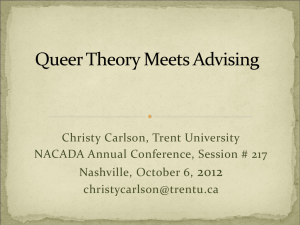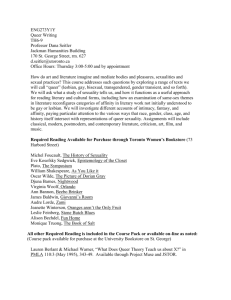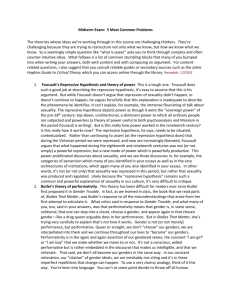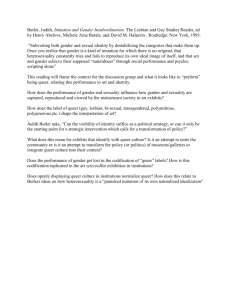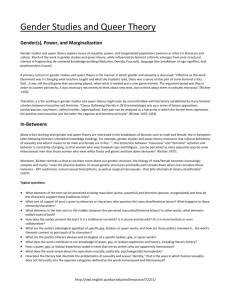Queer Theory - Brianna Mercadante
advertisement
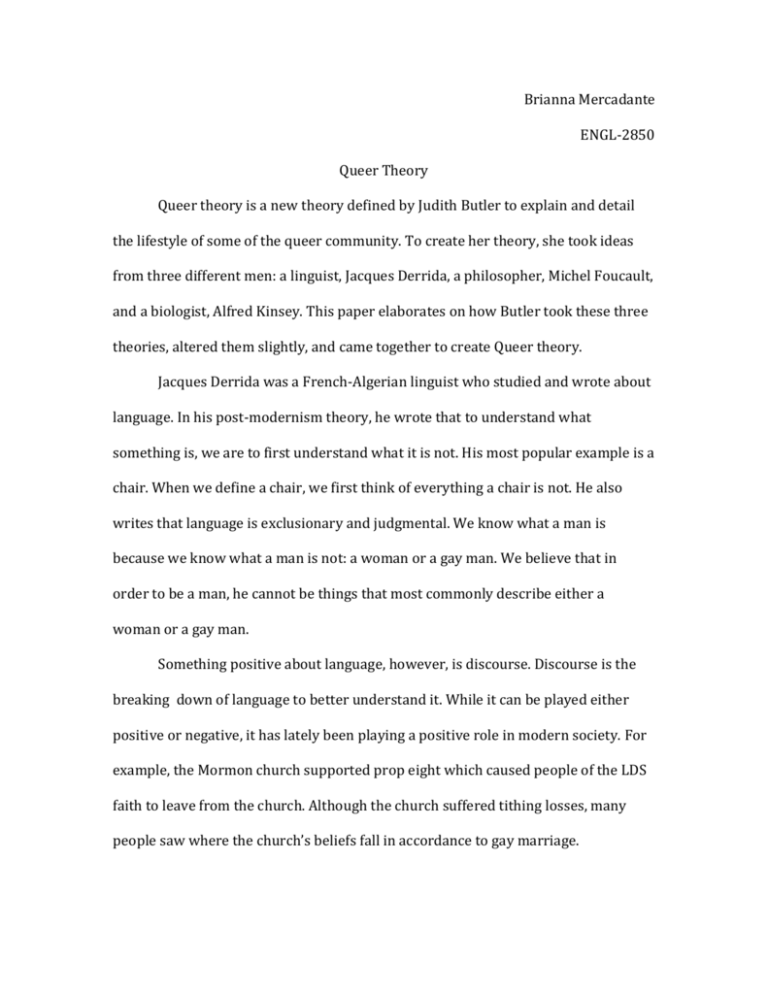
Brianna Mercadante ENGL-2850 Queer Theory Queer theory is a new theory defined by Judith Butler to explain and detail the lifestyle of some of the queer community. To create her theory, she took ideas from three different men: a linguist, Jacques Derrida, a philosopher, Michel Foucault, and a biologist, Alfred Kinsey. This paper elaborates on how Butler took these three theories, altered them slightly, and came together to create Queer theory. Jacques Derrida was a French-Algerian linguist who studied and wrote about language. In his post-modernism theory, he wrote that to understand what something is, we are to first understand what it is not. His most popular example is a chair. When we define a chair, we first think of everything a chair is not. He also writes that language is exclusionary and judgmental. We know what a man is because we know what a man is not: a woman or a gay man. We believe that in order to be a man, he cannot be things that most commonly describe either a woman or a gay man. Something positive about language, however, is discourse. Discourse is the breaking down of language to better understand it. While it can be played either positive or negative, it has lately been playing a positive role in modern society. For example, the Mormon church supported prop eight which caused people of the LDS faith to leave from the church. Although the church suffered tithing losses, many people saw where the church’s beliefs fall in accordance to gay marriage. Michel Foucault was a French philosopher that questioned sexuality and argued against philosophers such as Plato. In his lifetime, he wrote a series of books that documented sexuality over a period of 2,000 years. In the series he documents how sexuality of any kind was once easily accepted, then turned into a sin, then later came to be what it is today. Foucault sheds much light on the Victorian age and how it came to change sex from a biological need to a sin against God. In his second theory, he wrote more in depth about the Panopticon, the perfect prison. From the story, he explains that the perfect prison, the Panopticon, is a circle with glass windows so the prisoners can see each other, but they cannot see the guards. Because of this building, the prisoners are forced to watch what they are doing at all times in fear the guards could be around. The story is an allegory for today’s society and how we, as a community, began to self-police. People have started to watch what they are doing because they are afraid others will see them and judge them accordingly. The theory can closely relate to the Big Brother theory from George Orwell’s 1984. His last theory argues against Plato’s theory that we can get to know ourselves. Foucault argues that people can never actually know themselves. There is no way a person can step out of themselves, sit down, and have a conversation with themselves to get to know them. A person can get to know a friend or another person, but they can never know themselves. Alfred Kinsey was an American biologist who pushed the boundaries of human sexuality. During his experiments, he came up with what we now consider the Kinsey Scale. In this scale, a person is to answer many questions that determine their sexuality. Post-Kinsey the questions are scaled in many different categories: sex, gender, orientation, identification, practice, attraction, and philias. Each of the categories has a different meaning, which a person is scaled on. The first is sex, which is biological, a person’s genes (XX, XY). The second is gender, which is a social construct, female and male. Another is orientation, also a social construct, and is defined by gay, straight and bisexual, however one person defines another. The difference from that is identification, which is a personal choice with how people identify themselves. Another choice is practice, such as vaginal, oral or anal sex. Psychology wise, there are things such as philias and fantasies. Some philias include furies, feet or pedophilia, all which are not choices; they are something we cannot control. Something that is unknown, though, is where attraction comes from. There are theories such as women date their fathers, but nothing has ever been surely confirmed. The Kinsey Scale is a scale of one through six that a person would be placed on after answering a few questions. Kinsey said that throughout all of his research, he never met anyone that identified with either a one or a six. What he also noticed is that women are more fluid in their sexuality than men. They tend to lean more towards homosexual thoughts than men do. Kinsey also says that our wants and desires come from dreams and fantasies. Judith Butler is one of the most known and provocative theorists. She was able to take the theories of Derrida, Kinsey, and Foucault and combine them to make what is now known as Queer Theory. She selected specific ideas from each of them, altered them slightly and put them together. From Derrida, she took his theories that language is exclusionary, binary, and judgmental. This allowed her to explain how damaging and hurtful language could become. She also explained that although he says we fix language with deconstruction it is not nearly enough. For Butler, deconstruction was not the answer, going upstream was the answer to fix language. Society needs to move from the dirty water, to upstream to see where the dirty water is coming from. The most upstream question is: Who benefits? One facet of language is that it is preformative. People do not realize what they are doing; they naturally act a certain way. People naturally fit into certain gender roles that society has made for us. Women tend to act nurturing and caring while men act tough and strong due to social constructs. This theory leads to the glass box theory from Foucault. From Foucault she took the theories of self-policing and explained that is why we stop at a red light although it is three in the morning. Butler also explains that we all live in a little glass box, the Panopticon. She later goes on to say that we need to just be. We should not feed into those stereotypes we should not label ourselves. Not be ‘ourselves’ but just simply be, simply exist. She says we should never self identify. Lastly, she took Kinsey’s ideas of scaling a person’s orientation. She took the ideas of the difference between gender and sex, orientation and identification, and practice and attraction. However, she does not fully agree with the Kinsey scale. She says that if we try to define ourselves on a scale, we are fitting into a stereotype and a label, which we should never do. Again, she says we should simply be. By taking these three theories and combining them, she created Queer Theory. Judith Butler is noted as being the woman who created Queer theory. She took Derrida’s ideas of language and explained how they work in the queer community. She took Foucault’s theory of self-policing and explained how people in modern society do it every day to fit into gender roles. Finally, she took Kinsey’s ideas of sexual labeling and said that we should never label ourselves. By putting these three theories together she created what our community now recognizes and studies as Queer Theory.sdwoiiiiip06555555ttttt ‘
